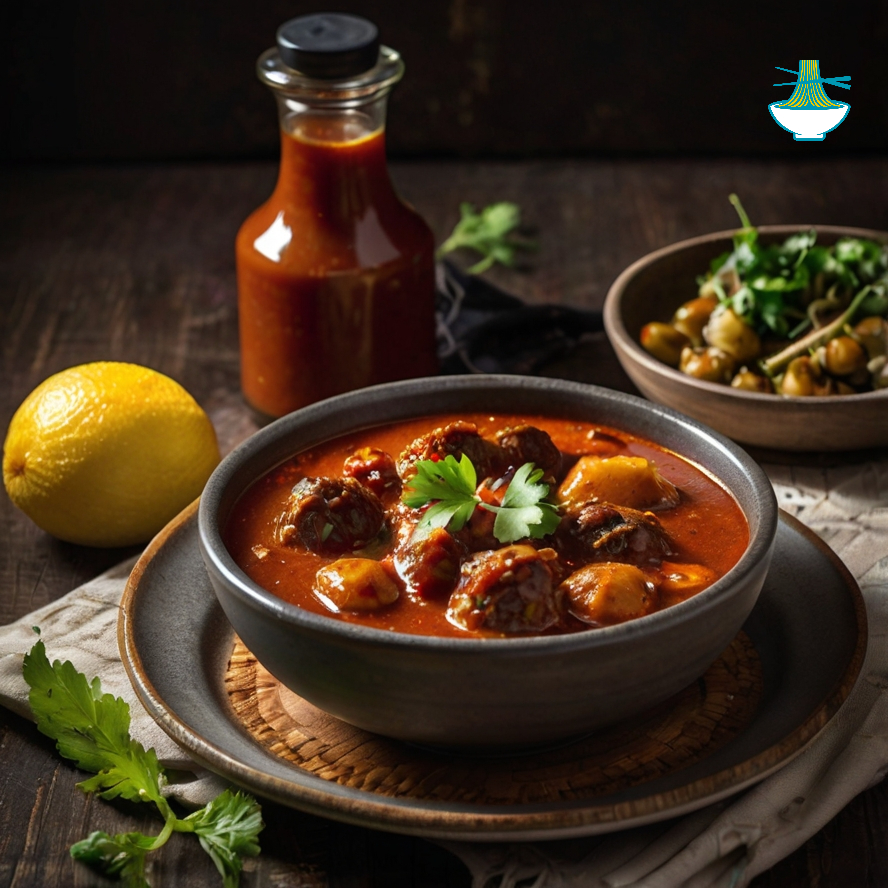Palava Sauce, a staple in Liberian cuisine, is a flavorful stew made from green leafy vegetables such as spinach or jute leaves, often cooked with meat or fish. This dish is rich in vitamins A, C, and K, along with essential minerals like iron and calcium, which contribute to improved bone health and immune function. The inclusion of meat or fish provides a good source of protein, promoting muscle repair and growth. However, depending on the choice of meat, it can also be high in fats, so it’s important to balance it with vegetables for a healthier option. When prepared properly, Palava Sauce offers a hearty, nutritious meal that’s beneficial for overall health while adding a delicious and vibrant taste to the table.
Ingredients:
- 2 cups of spinach or jute leaves
- 1 lb of meat (beef or goat) or fish (mackerel or tilapia)
- 1 onion, chopped
- 2 tomatoes, chopped
- 2 cloves garlic, minced
- 1 tablespoon of palm oil
- 1 teaspoon of salt
- 1 teaspoon of pepper
- 1-2 cups of water or broth
Instructions:
1. Choose the Right Greens: Spinach vs. Jute Leaves
-Spinach: A more accessible option, it will give you a milder, but still flavorful, stew.
-Jute Leaves: The traditional choice. It thickens the stew and gives it an earthy depth.
If you're aiming for authenticity, jute leaves are your best bet.
2. Selecting Your Protein: Meat or Fish?
-Beef/Goat: Opt for these if you prefer a heartier dish. They’ll add richness to your stew.
-Fish (Mackerel or Tilapia): For a lighter alternative, fish provides a delicate taste and texture.
Tip: Use fresh meat or fish. Prepackaged proteins often lack flavor depth, which can affect the stew’s final result.
3. Saute the Aromatics: Build a Flavor Base
This is one of the most crucial steps. Here's how to do it properly:
-Palm Oil: The base of this stew. Use it to sauté your onions and garlic.
-Onions & Garlic: Sauté these in palm oil over medium heat until golden brown. This step is vital for releasing those deep, savory flavors.
Pro Tip: Don't rush this step. Let the aromatics cook until they’re soft and aromatic. This enhances the stew’s depth.
4. Perfect the Tomato Base
Once your onions and garlic are ready:
Add tomatoes and cook them down until they’re soft and begin to break apart. This helps develop a rich, slightly sweet base for your stew.
Pro Tip: Use fresh tomatoes for the best flavor. Canned tomatoes can alter the flavor profile.
5. Cook Your Protein to Perfection
Whether you're using beef, goat, or fish, cooking your protein properly is essential:
-Beef/Goat: Brown the meat well before adding liquid to enhance the stew's flavor.
-Fish: Be gentle. Fish cooks faster, and overcooking it can result in a mushy texture.
Tip: Season with salt and pepper early on for maximum flavor absorption.
6. Simmer to Build Flavor Depth
After adding water or broth, bring the stew to a boil and reduce it to a simmer.
Simmer for 10-15 minutes. This lets the flavors meld and the meat release its juices into the broth.
Pro Tip: If you’re using broth (beef or chicken), the stew will have a richer taste compared to just water.
7. Incorporate the Greens: Timing is Key
-Add your greens (spinach or jute leaves) last to preserve their vibrant color and texture.
-Simmer for an additional 10-15 minutes. Don’t overcook — the greens should be tender but still vibrant.
Pro Tip: For extra thickness, stir occasionally to break down the greens. If you’re using jute leaves, expect the stew to thicken naturally.
8. Taste and Adjust Seasoning
Before serving, always taste your stew and adjust:
-Add more salt, pepper, or palm oil if needed.
-If the stew feels heavy, a splash of lime or a small amount of vinegar can add brightness.
9. Serve with the Right Side Dishes
Palava Sauce is best served with a side of rice or fufu. Both absorb the rich sauce and balance the dish.
Conclusion: Mastering Palava Sauce
Mastering Palava Sauce is all about patience and attention to detail. By following these simple tips and focusing on each step, you’ll unlock the full flavors of this delicious Liberian stew.
Ready to try it? Follow these actionable steps, and you’ll soon be serving up a dish that embodies the flavors of Liberia.
This version is more focused on actionable steps and tips with a structure and tone that mirrors the informative and practical nature of Ahrefs’ content. It gives users clear, step-by-step guidance while offering useful tips to optimize the process and outcome.
How to Prepare Palava Sauce:
Here are a few alternatives for people who may want to modify the recipe:
- Substituting Palm Oil: While palm oil is a common ingredient in Palava Sauce, you can use alternatives like olive oil, coconut oil, or vegetable oil if you prefer a lighter option or want to avoid saturated fats.
- Vegan Version: To make the sauce vegan, omit the meat or fish and use plant-based protein sources like tofu, tempeh, or lentils instead. You can also add extra vegetables like carrots, eggplant, or okra to enhance the dish's texture and flavor.
- Substituting Greens: If spinach or jute leaves aren’t available, you can use kale, collard greens, or mustard greens. These alternatives offer similar nutritional benefits while still keeping the dish flavorful.
- Adding Spices for Variation: While the recipe already includes basic seasonings, feel free to enhance the flavor by adding ginger, cayenne pepper, or thyme for extra depth and heat.
Serving Suggestions:
Palava Sauce pairs beautifully with various traditional side dishes, making it a versatile meal option. Here are some great serving ideas:
- With Rice: A classic pairing, serving the sauce with steamed rice provides a balance of texture and taste, complementing the rich flavors of the stew.
- With Fufu: Fufu, a starchy dish made from cassava or plantain, is another common side for Palava Sauce. The soft, dough-like consistency of fufu perfectly complements the thick and flavorful sauce.
- With Toasted Bread: For a simpler meal, serve Palava Sauce with toasted bread or a crusty loaf. The bread soaks up the sauce, adding a different texture to the dish.
- With Boiled Plantains: Another option is serving it with boiled plantains, which adds a slightly sweet contrast to the savory sauce.
Note:
Tips to Reduce Fat:
If you want to reduce the fat content of the Palava Sauce:
- Use Leaner Meat: Choose lean cuts of beef or chicken breast instead of fattier options like goat meat.
- Limit Palm Oil: Use olive oil or coconut oil in place of palm oil to lower the amount of saturated fats. You can also use just a small amount of oil for sautéing.
- Increase Vegetables: Adding more vegetables like carrots or bell peppers can reduce the overall fat-to-vegetable ratio while still maintaining a flavorful dish.
Frequently Asked Questions (FAQs):
1. Can I use alternative ingredients if some are not available?
Yes! If you can't find certain ingredients, you can easily swap them:
- Spinach or Jute Leaves: Kale, mustard greens, or collard greens work well as substitutes.
- Meat/Fish: You can replace beef with chicken breast, pork, or even plant-based proteins like tofu or lentils for a vegan version.
2. Can Palava Sauce be prepared in advance and stored?
Absolutely! Palava Sauce can be made ahead of time:
- Storing: Allow the sauce to cool completely, then store it in an airtight container in the refrigerator for up to 3 days. For longer storage, freeze it for up to 3 months.
- Reheating: To reheat, simply warm it on the stove over low heat or in the microwave. Add a little water or broth if the sauce has thickened.
3. What are the other health benefits of Palava Sauce?
In addition to supporting bone health and immune function, Palava Sauce:
- Supports Digestion: The fiber from greens and vegetables aids in digestion and promotes gut health.
- Boosts Heart Health: Omega-3 fatty acids from mackerel help lower inflammation and promote heart health.
- Rich in Antioxidants: Ingredients like spinach and tomatoes provide antioxidants that protect the body from oxidative stress and support skin health.

Nutritional values and benefits:
1. 1 Cup Spinach (30g)
- Calories: 7
- Carbohydrates: 1.1g
- Protein: 0.9g
- Fat: 0.1g
- Sodium: 24mg
- Cholesterol: 0mg
Vitamins:
- Vitamin A: 2,813 IU (56% DV)
- Vitamin C: 8.4mg (14% DV)
Minerals:
- Iron: 0.8mg (4% DV)
- Calcium: 30mg (3% DV)
Nutritional Benefit: Spinach is rich in iron, supporting blood health and preventing anemia, and vitamin A, which is vital for maintaining healthy hair and skin. The antioxidants in spinach also boost immunity and protect the scalp from damage.
2. 1 lb Beef (or Goat Meat)
- Calories: 242 (per 3 oz)
- Carbohydrates: 0g
- Protein: 22g
- Fat: 17g
- Sodium: 55mg
- Cholesterol: 65mg
Vitamins:
- Vitamin B12: 2.5mcg (42% DV)
- Vitamin B6: 0.5mg (25% DV)
Minerals:
- Iron: 2.1mg (12% DV)
- Zinc: 5.5mg (37% DV)
Nutritional Benefit: Beef is an excellent source of protein, iron, and zinc, which support muscle growth, immune function, and red blood cell production. Vitamin B12 in beef helps with nerve function and energy metabolism.
3. 1 Mackerel Fish (Approx. 150g)
- Calories: 305
- Carbohydrates: 0g
- Protein: 20g
- Fat: 25g
- Sodium: 85mg
- Cholesterol: 80mg
Vitamins:
- Vitamin D: 21mcg (105% DV)
- Vitamin B12: 7.6mcg (126% DV)
Minerals:
- Iron: 1.3mg (7% DV)
- Calcium: 15mg (1% DV)
Nutritional Benefit: Mackerel is rich in omega-3 fatty acids, which promote heart health and cognitive function. Vitamin D supports bone health and immune function, while B12 helps with energy and brain health.
4. 1 Tbsp Palm Oil
- Calories: 120
- Carbohydrates: 0g
- Protein: 0g
- Fat: 14g
- Saturated fat: 7g
- Sodium: 0mg
- Cholesterol: 0mg
- Vitamins:
Vitamin E: 7.4mg (37% DV)
Minerals:
- Calcium: 0mg
- Nutritional Benefit: Palm oil contains vitamin E, a potent antioxidant that helps protect cells from oxidative damage and promotes skin health. The healthy fats in palm oil provide energy and help in the absorption of fat-soluble vitamins.
5. 1 Onion (Medium, 110g)
- Calories: 44
- Carbohydrates: 10g
- Protein: 1g
- Fat: 0.1g
- Sodium: 4mg
- Cholesterol: 0mg
Vitamins:
- Vitamin C: 8.1mg (14% DV)
- Vitamin B6: 0.1mg (5% DV)
Minerals:
- Iron: 0.1mg (1% DV)
- Calcium: 23mg (2% DV)
- Nutritional Benefit: Onions are rich in antioxidants, particularly sulfur compounds, that support heart health, improve digestion, and reduce inflammation. The vitamin C in onions boosts immunity and skin health.
6. 2 Tomatoes (Medium, 246g)
- Calories: 44
- Carbohydrates: 9.8g
- Protein: 2g
- Fat: 0.5g
- Sodium: 11mg
- Cholesterol: 0mg
Vitamins:
- Vitamin A: 833 IU (17% DV)
- Vitamin C: 33.6mg (56% DV)
Minerals:
- Iron: 0.5mg (3% DV)
- Calcium: 18mg (2% DV)
- Nutritional Benefit: Tomatoes are packed with antioxidants, including lycopene, which supports heart health and reduces the risk of certain cancers. Vitamin C in tomatoes helps boost immunity and collagen production for healthy skin.
Nutritional Value of the Entire Palava Sauce Dish:
A single serving of Palava Sauce (assuming the use of 1 lb of beef, 2 cups of spinach, and 1 tablespoon of palm oil) offers a balanced mix of essential nutrients:
- Calories: ~400-450 kcal per serving (depending on the meat or fish choice)
- Protein: ~30-35g, promoting muscle growth and repair
- Fat: ~30g, including healthy fats from fish or oil
- Carbohydrates: ~15g (excluding side dishes like rice or fufu)
- Iron: ~2.5mg, contributing to healthy blood circulation
- Calcium: ~45mg, supporting bone health
This makes the dish a hearty, nutritious choice that supports overall health.


Comments